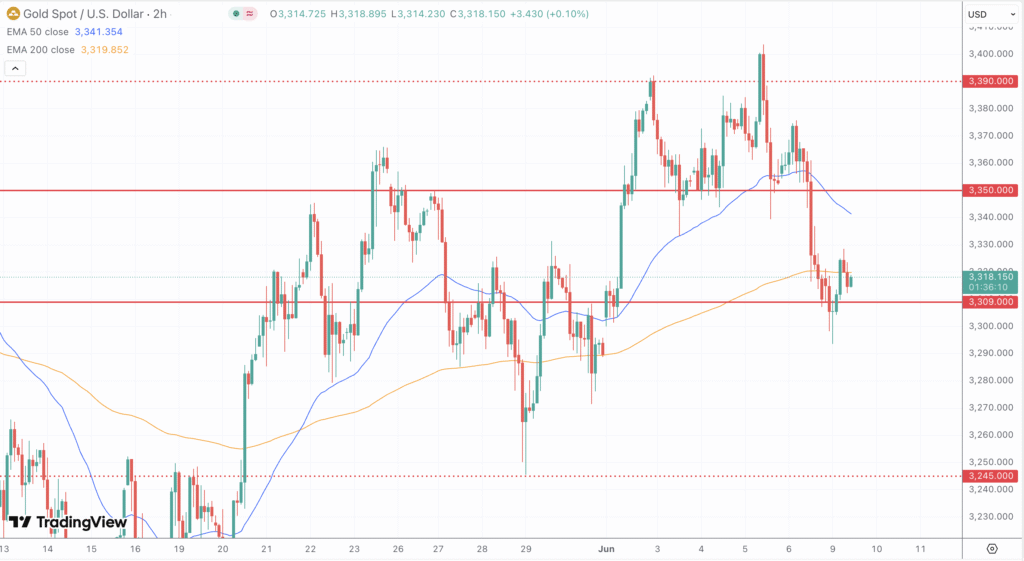Principais Conclusões
- Gold remains range‑bound near $3,300–$3,350, influenced by a softer dollar and trade concerns.
- Technical setup shows a potential bullish reversal if Gold clears $3,343–$3,350 zone; failure to do so could retest $3,290–$3,245.
- Fed expectations have shifted, reducing the likelihood of near‑term cuts; Treasury yields near 4.3% continue to weigh.
- Next week’s US data and trade outcomes will be decisive: weak data or trade uncertainty favors Gold; strong prints may press it lower.
- Volume and EMA levels offer tactical support—watch the 50‑ and 200‑EMA around midday charts for entry opportunities.
Market Dynamics and Recent Performance
Gold has been holding firm recently in the $3,300–$3,350 range, retracing from a near-2% drop late last week. The backdrop is a softer US Dollar ahead of the US‑China trade talks, lending support to bullion’s safe‑haven appeal.
Robust US labor data—139 k NFP jobs added in May, unemployment steady at 4.2%—has muted Fed rate‑cut expectations, keeping yields firm and under pressure from rising Treasury yields. Meanwhile, geopolitical and trade tensions continue to fuel demand for defensive assets.
Technical and Fundamental Influences
From a technical standpoint, Gold has recently formed a bearish engulfing candle and broken the lower boundary of its ascending channel, dragging prices down to near $3,290, the neckline of a minor head‑and‑shoulders pattern. This move triggered a bounce toward the previous support‑turned‑resistance zone near $3,340–$3,350.

Short‑term moving averages offer support: on the 2‑hour chart, the 50‑EMA ($3,343) and 200‑EMA ($3,319) are key inflection points. Traders are eyeing a sustained recovery above the 50‑EMA to claim bullish momentum, with resistance at $3,343–$3,350. A failure there could see another dip to the $3,309–$3,290 support region—and potentially toward $3,245 on a deeper pullback.
On the fundamentals, the Fed remains a central factor: rate‑cut probabilities for later this year have fallen from around 70% to the mid‑30s, given resilient labor and inflation metrics. Treasury yields—10‑year notes near 4.3%—are detracting from non‑yielding Gold. Still, dovish commentary, dovetailing with trade uncertainties and central bank reserve buying, continue to buoy bullion. A Reuters poll now forecasts average gold prices exceeding $3,000 in 2025, with risk to the upside if trade tensions persist.
Looking Forward
Heading into next week, the key events remain US‑China trade negotiations and US economic data: ADP payrolls, ISM Services PMI, and the June NFP report. A soft NFP print could reignite rate‑cut hopes, pushing yields lower and providing a tailwind to Gold. Technically, a clear break above $3,343–$3,350 could pave the way to $3,400–$3,450, possibly resuming the uptrend. Conversely, a strong US data beat or successful trade dialogue could drive USD strength and Treasury yields higher—prompting Gold to test the $3,290–$3,245 support range.
Volume patterns on shorter time frames also hint at a possible bullish reversal: recent retests of $3,309–$3,290 zones have seen increased volume, suggesting demand at those levels . Traders may watch for a bullish candle setup at the key support zone to consider re-entering long positions.

